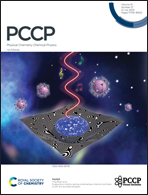Low-energy electron interaction with 2-(trifluoromethyl)acrylic acid, a potential component for EUVL resist material†
Abstract
Motivated by the current introduction of extreme ultraviolet lithography (EUVL) into chip manufacturing processes, and thus the transition to electron-induced chemistry within the respective resist materials, we have studied low energy electron-induced fragmentation of 2-(trifluoromethyl)acrylic acid (TFMAA). This compound is chosen as a potential resist component, whereby fluorination enhances the EUV adsorption and may at the same time promote electron-induced dissociation. Dissociative ionization and dissociative electron attachment are studied, and to aid the interpretation of the observed fragmentation channels, the respective threshold values are calculated at the DFT and coupled cluster level of theory. Not surprisingly, we find significantly more extensive fragmentation in DI than in DEA and in fact, the only significant DEA fragmentation channel is the cleavage of HF from the parent molecule upon electron attachment. Rearrangement and new bond formation are substantial in DI and are, in fact, similar to DEA, mainly associated with HF formation. The observed fragmentation reactions are discussed in relation to the underlying reactions and potential implications for the suitability of TFMAA as a component of EUVL resist materials.



 Please wait while we load your content...
Please wait while we load your content...